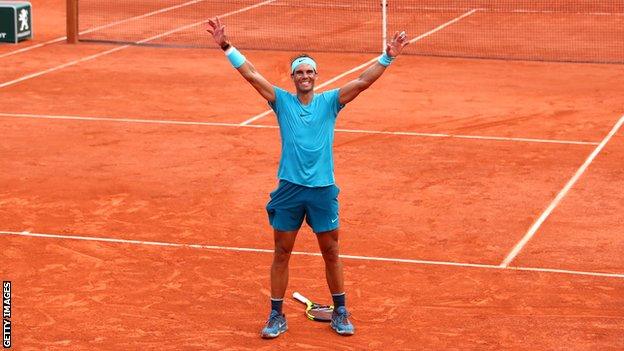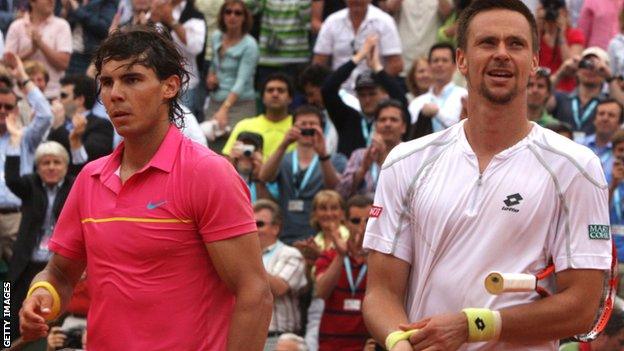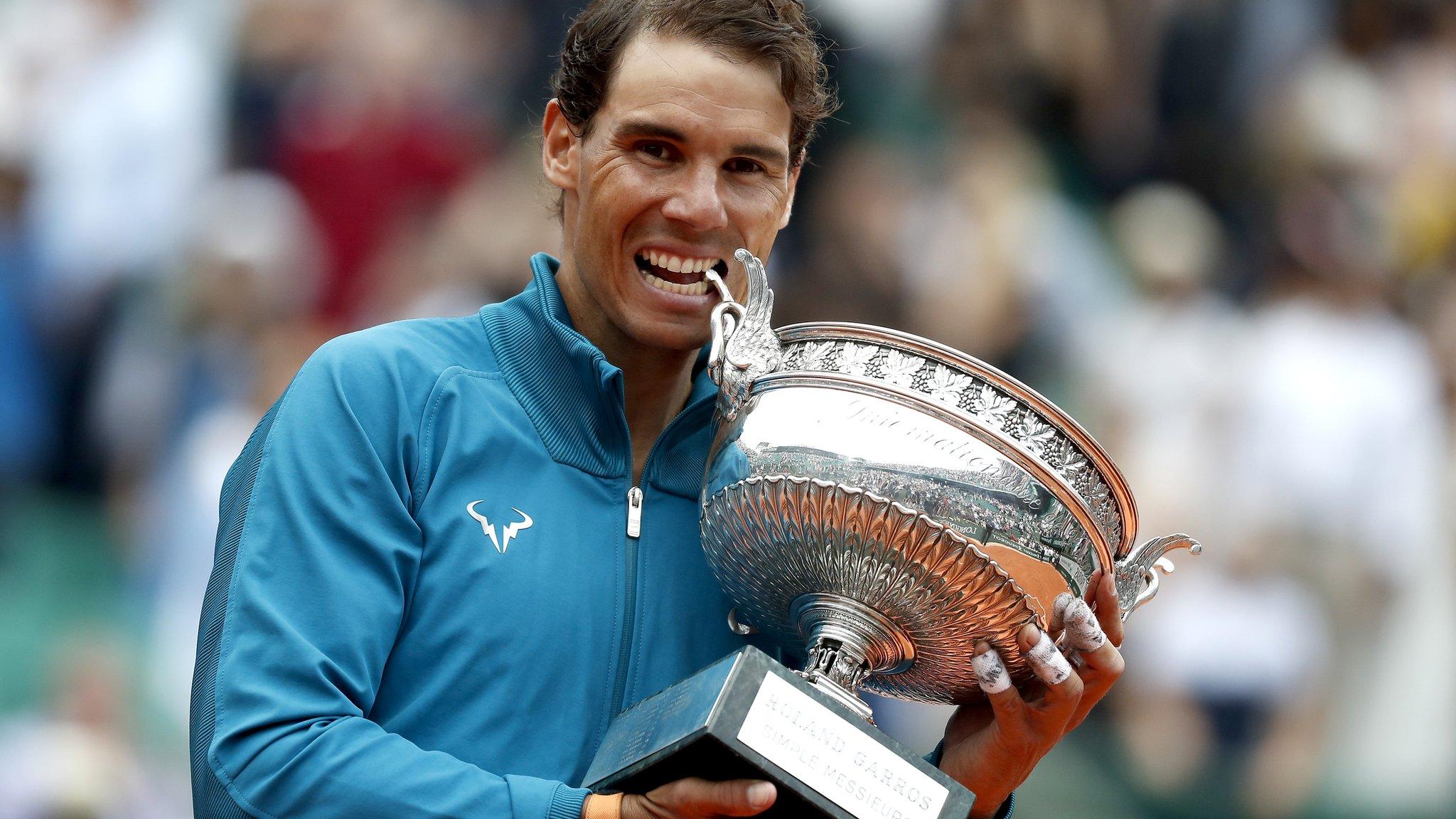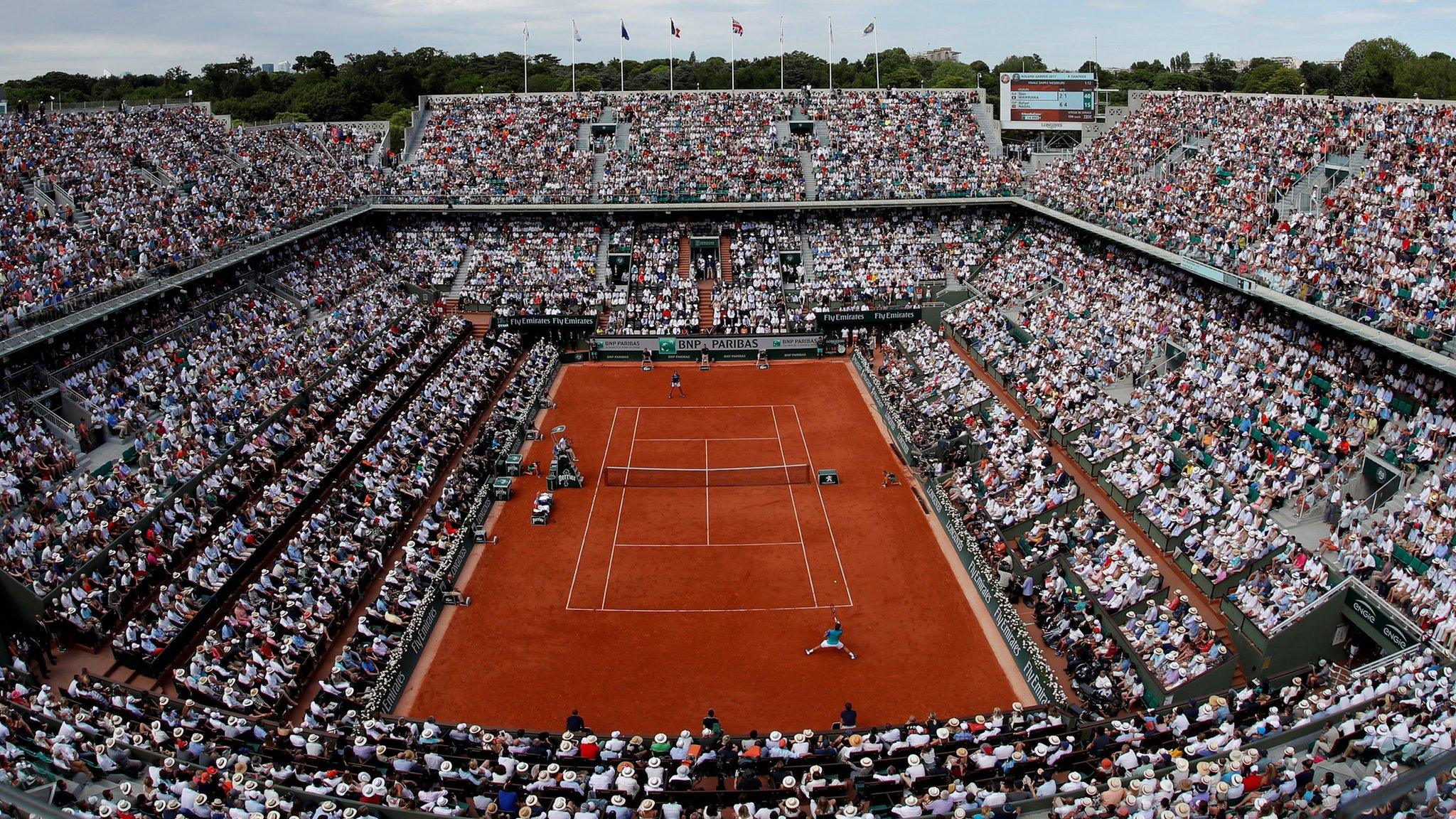French Open 2018: Why does 'King of Clay' Rafael Nadal reign supreme?
- Published
- comments

Spain's Rafael Nadal won his 11th Roland Garros title against Austria's Dominic Thiem
2018 French Open men's final |
|---|
Venue: Roland Garros, Paris Date: Sunday, 10 June Time: 14:00 BST |
Coverage: Live radio and text commentary on BBC Radio 5 live, the BBC Sport website and app. |
The beauty about sport is we never know what might happen when we arrive at a stadium or turn on our television.
But one thing comes as close to sporting certainty as anything else we have seen over the past 13 years: Rafael Nadal winning the French Open.
"Some say beating Rafa over five sets on clay is the toughest thing in sport - not just tennis," says seven-time Grand Slam singles champion John McEnroe. "I would agree with that."
Since making his debut as a talented teenager in 2005, Nadal has won a record 11 singles titles at Roland Garros - no-one in the men's game has managed to win as many at the same Grand Slam.
And the 32-year-old Spaniard lifted the Coupe des Mousquetaires yet again on Sunday, beating Austrian seventh seed Dominic Thiem 6-4 6-3 6-2.
What makes the man nicknamed the 'King of Clay' almost unstoppable on the red dirt?
We've asked former Grand Slam champions McEnroe, Michael Chang and Pat Cash, along with analysts and journalists, to tell us.
His vicious forehand and movement

Nadal's run of winning 37 successive sets at Roland Garros stretched back to 2015
Nadal won 37 sets in a row at Roland Garros, surpassing his own previous best streak of 32, before Argentine 11th seed Diego Schwartzman stopped him moving closer to Bjorn Borg's all-time record of 41 by winning the opener in their quarter-final.
Borg won six French Open titles between 1974 and 1981, setting a record that stood until it was surpassed by Nadal in 2012.
"I was around the era where I thought I was watching the greatest - I was at the time - Borg. Nadal eclipses him," said McEnroe, a Roland Garros finalist in 1984.
Nadal's main weapon is that vicious, lasso-style forehand which has become his trademark.
Nobody has hit a higher percentage of forehand winners than the Spaniard over the past fortnight, with 12% of his points coming through this shot.
That, added to his sharp movement and supreme athleticism, is what makes Nadal great, according to Chang.
"He has the uncanny ability of being able to hit a lot of forehands and move very well on clay," the American, who won Roland Garros as a 17-year-old in 1989, told BBC Sport.
"He knows how to manipulate the angles to build to get people out of position.
"He is very aggressive, although patient when he needs to be, but for the most part if the shot is there he is taking it and going for it.
"He's the one manipulating, making you move and putting you in awkward positions to the point where he has easy cutaways."
Being a leftie
Nadal is a left-handed player which, in conjunction with his other attributes, is a key part to his success, according to Chang.
"If Rafa was a right-handed player I don't think his game would be quite as effective," said the former world number two.
"Being a leftie means that everything spins the other way.
"The strong forehands always come into a right-handed player's backhand, hooking him off the court, and the inside-out coming back the other way, it is tough to cover."
Second serve
In tennis, the second serve is the ultimate safety net, allowing players to go all out on their first serve, knowing they have a back-up if they miss.
Second serves are slower and weaker than first serves, and in men's tennis, these points are where the real contest is waged, says tennis journalist Amy Lundy.
Lundy has produced an in-depth analysis of Nadal's second service game, external over the past year and believes a significant improvement in this area is the key to his continued dominance on the red dirt.
"Nadal is taking this backstop and using it to crush his opponents," she told BBC Sport.
"For most professional tennis players, anything above winning 50% of their second serve points is considered good.
"On clay, Nadal has driven up that percentage to over 66% won on second serve in the past year, heading into the 2018 French Open."
Growing up on clay courts
Clay is the natural surface for Spanish players, with about 100,000 red-dirt courts across the country - even most small villages have them.
So it is not surprising that Nadal is the latest in a long line of Spanish success - albeit far more sustained than his predecessors - at Roland Garros.
Nadal's 11 wins, plus triumphs for Sergi Bruguera (two), Carlos Moya, Albert Costa and Juan Carlos Ferrero, means the nation has accounted for 16 of the past 25 male champions.
"Roland Garros has always been the most special tournament for us," said Joan Solsona, a Spanish tennis journalist who has worked for daily sports newspaper Marca since 1998.
"So it affects the way you prepare as a tennis player - you want to be good on clay. Playing and learning on clay is natural for Spanish people."
Majorca-born Nadal first stepped on to clay aged four, starting to practise at his local tennis club in Manacor with his uncle Toni - the man who developed and coached him until retiring last year.
"Nadal was from a small town of 40,000 people and his local club had six or seven clay courts," added Solsona.
"We are lucky because Spain is a sunny country and this has a big effect. The clay courts stay in good condition in the good weather and means you can practise on them all year round because of the weather.
"We're also advised that playing on clay is the best surface for children to learn on because it is easier to move on and means they don't get injured as much.
"So Rafa started moving on clay from a young age and it shows."
'Perfect' conditions
The clay surface slows the ball down more than grass, enabling Nadal to use his athleticism to construct his points and tee up that famed forehand.
In turn, it helps him hit the ball harder and more accurately, while the hotter summer temperatures in mainland Europe - where the majority of the clay-court season takes place - help Nadal generate more bounce.
It is notable that Nadal's successes in Monte Carlo and Rome, two of the Tour's three clay-court Masters tournaments, outnumber those in Madrid - the third - as the high altitude of the Spanish capital means the ball moves quicker.
"The conditions at Roland Garros suit him perfectly," said Thiem, who has lost all three of his meetings with Nadal in Paris. "It's similar to Monte Carlo, where he also plays amazing.
"Also the court at Roland Garros is very big. We can return very far behind the baseline. That's an advantage to him. And I think the balls, we like them."
Nadal's least impressive performance came in the opening set of his quarter-final against Schwartzman, on a colder and damp day before he fought back in warmer conditions, although the 17-time Grand Slam champion said afterwards it did not make a difference.
"Some people say it has to be a cold day where he can't get the ball through the court," Cash, who reached the fourth round at the 1988 French Open, told BBC Radio 5 live.
"But if Rafa can't get the ball fast through the court then who can?
"The hot conditions suit Rafa. He's bouncing those balls in above your shoulders - they are a foot or two higher than any other player on the circuit."
Rafa's clay-court dominance since 2005 | |
|---|---|
French Open | 2005, 2006, 2007, 2008, 2010, 2011, 2012, 2013, 2014, 2017, 2018 (11) |
Monte Carlo Masters | 2005, 2006, 2007, 2008, 2009, 2010, 2011, 2012, 2016, 2017, 2018 (11) |
Rome Masters | 2005, 2006, 2007, 2009, 2010, 2012, 2013, 2018 (8) |
Madrid Open* | 2010, 2013, 2014, 2017 (4) |
Barcelona Open | 2005, 2006, 2007, 2008, 2009, 2011, 2012, 2013, 2016, 2017, 2018 (11) |
*Nadal also won one title in 2004 before Madrid changed from a hard court to a clay court.
How do you beat him?
Nadal has only lost twice at Roland Garros - he pulled out before his last-32 match against fellow Spaniard Marcel Granollers in 2016 with a wrist injury.
Long-time rival Novak Djokovic was the last person to actually beat him on court, winning in straight sets in their 2015 quarter-final.
Djokovic went into the match as the favourite, being the world number one and on a 26-match winning streak.
Nadal's first defeat at Roland Garros, however, was a seismic shock.
A last-16 victory in 2009 earned Robin Soderling, an unheralded Swede who had never previously checked into the second week of a Grand Slam, a place in the sport's history books.

Soderling beat Nadal 6-2 6-7 (2-7) 6-4 7-6 (7-2) at Roland Garros in 2009
"On that day everything worked for me," Soderling told BBC World Service.
"You have to be extremely aggressive. There is no other way of beating him on clay.
"You have to play a little bit flatter than you usually do, play close to the baseline and take your chances.
"You need to play with smaller margins and take some risks because no-one will beat him staying two metres from the baseline and beating him on his own terms. You have to take the initiative."
Nadal's march to his 11th title
Stage | Opponent | Result | Time |
|---|---|---|---|
First round | Simone Bolelli | 6-4 6-3 7-6 (9-7) | 2hr 57 |
Second round | Guido Pella | 6-2 6-1 6-1 | 2hr 03 |
Third round | Richard Gasquet | 6-3 6-2 6-2 | 1hr 58 |
Fourth round | Maximilian Marterer | 6-3 6-2 7-6 (7-4) | 2hr 30 |
Quarter-finals | Diego Schwartzman | 4-6 6-3 6-2 6-2 | 3hr 50 |
Semi-finals | Juan Martin del Potro | 6-4 6-1 6-2 | 2hr 14 |
Final | Dominic Thiem | 6-4 6-3 6-2 | 2hr 42 |
- Published10 June 2018

- Published9 June 2018

- Published11 October 2020
